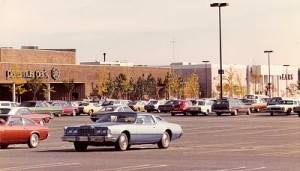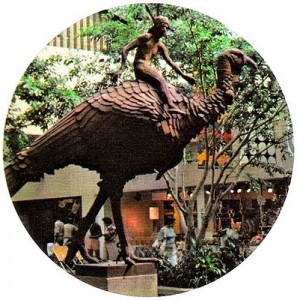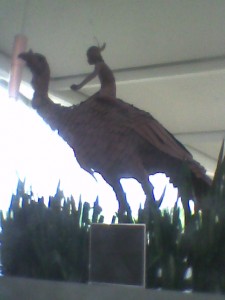These days, when I want to buy something, first I’ll check to make sure I’m not distracting myself from something actually important. Usually I am, so my shopping plans stop right there. But, if I’ve determined that my well-being may genuinely depend on me increasing the number of things in my possession, I’ll look online at whatever reviews I can find for whatever thing it is I’ve decided I can no longer hold my head up in public without. Then I may, if absolutely needed, check out discount stores, eBay, anywhere on the face of the Earth but in one of those high-overhead, hyped magnets for those with nothing better to do than to bask in the reflected glow of epitomized artificially inflated retail nightmarishness known as a shopping mall.
But I remember when going to the mall, just for something to do, without even a shopping list, used to seem like a pretty OK way to spend the precious moments of my human life. My friends and I would hang out at the record store, the skinny tie store, check out the girls, the ice cream selection, plan our fifth viewing of Star Wars, and maybe have a slice of pizza. We were eleven. These days I’m more of a mind that eleven-year-olds would benefit much more profoundly from a trip to the local penitentiary than to a shopping mall, but back then my concept of the heavenly realm was the same as my grandmother’s: shopping at the Paramus Park shopping mall in Paramus, NJ, next to which my local mall seemed as exciting as a post office.

Whenever I visited Grandma, in Ramsey, New Jersey, less than a half-hour’s drive from the shopping Mecca of our known universe, the big treat my younger self lived in silent expectation for was a trip to the wonderland that was Paramus Park. It had glass ceilings, an indoor merry-go-round,, full-size trees growing in the hallways, escalators with stone waterfalls along their sides with plants growing out of the “cracks” between the “rocks,” and water dripping off of them like on a really good Disney ride. A glass elevator ascended toward real clouds, giving the rider a full view of all the trees and waterfalls, gourmet chocolate stores and restaurants bathed in natural, tree-filtered sunlight; to me it was like stepping into Willy Wonka’s Factory. And in the center of it all was a eight foot high statue of a young native American boy riding a giant turkey.

I recently visited Paramus and decided to take our car in for an oil change. As is my wont, I left the car at the shop and went for a walk around the neighborhood. I meandered behind the Midas plaza, then alongside a creek at the back edge of the Home Depot parking lot. Through the trees on the opposite side of the creek, I caught a glimpse of the building beyond, and then the sign: “Paramus Park.”
I decided that an exploratory visit there, for old times’ sake, to see whatever changes the ravages of time hath wrought on my pre-teen version of the celestial kingdom, might boost my sense of detachment from temporary, material things. Plus, I’d have a cool, indoor place to chant (for me, walking means chanting) out of the hot sun.
First thing I noticed was a closed sporting goods store. The obscenely gigantic decorations were still in place – eight foot-high basketball and net, giant roller skates – but no merchandise. No people. Masking tape was on all the windows. When I went through the mall’s main entrance. I didn’t recognize the place at all. Then I realized I hadn’t been there in at least thirty years.
The glass elevator was no more. The waterfalls were no more. None of the stores I used to visit were there. It looked like all the life had been sucked out of it, all the sparkle that had made it seem spectacular and wonderful to me had been rubbed off.
I wanted to ask someone if there was anywhere I could go to find out the history of the place, just so I could see some evidence that the place had once actually had been able to charm me so profoundly. I found a security guard, a man perhaps in his sixties, looking like a genuine New York police officer. I explained how my grandmother used to bring me there thirty years ago, and I wondered how and why the place had changed so much.
“I been coming here for thirty years,” he told me, eyeing my beadbag suspiciously. “Yeah, it’s changed a lot. The elevator’s gone, the waterfalls are gone, they moved the merry go round down the hall, and they moved the turkey upstairs.”
I took an elevator (the new, prosaic, plain kind) up to the second floor, where Grandma used to take us to lunch at Farrell’s Old Time Ice Cream Parlor, where all the waiters dressed like it was 1917, with straw hats, striped shirts with garters on the sleeves, and a player piano played endless variations on Scott Joplin tunes. They still have stores in southern California and Hawaii, I’ve learned.
In a Post Office-like hallway there, in between a Dunkin’ Donuts and McDonald’s (“under new management”), surrounded by empty food court chairs which looked like they were on loan from a Greyhound station, was the turkey and its youthful Native American rider, with a plaque declaring how it had been presented to the Paramus Park Mall on it’s opening Day in 1974 by such and such.
I took some awful photos of it with my awful new cell phone, to accentuate the dreariness. There’s a plaque underneath it, which I’m sure I read many times as a kid:

“The Wild Turkey by Christopher Parks, presented to the Paramus community by the Rouse Company on the occasion of the opening of Paramus Park, March 14, 1974. The Leni Lenape Indians gave this land its name. One of the earliest written versions of the name in 1708 called it “Parames.” Later, it was referred to as ” Parampsepsus.” Dr. Charles A. Fillower, one of the best-known experts on the Leni Lenape language, says “Parampsepsus” means literally “where there is worthwhile or fertile land.” He adds that where there was fertile land, maize or indian corn was grown, and wild turkeys were also found in abundance, with their voracious appetite for corn. Thus, the meaning of Paramus: “a fertile land where corn was grown, attracting wild turkeys.”
How was the pizza?
I can relate. There are a few of these broke-down malls where I grew up too – for the most part they’ve been replaced by a huge ugly zone of big box shopping centers. I hated malls growing up in NC… certainly never thought that in hindsight they’d not seem so odious!
Have you seen this guy’s work:
http://notifbutwhen.com/projects/copia/dark-stores/
Anyway. Enough ranting. Glad you’re blogging again! I like your writing.
Thank you. Those photos show exactly what I’m talking about to an even more extreme degree. More examples of how disturbing entropy is to beings who aren’t meant to inhabit decaying bodies or a decaying world.
Wait a minute. Parampsepsis sounds a lot like the ultimate disease.
Yeah. I spelled it wrong initially. It’s Parampsepsus. Much easier to pronounce that way, especially with a mouthful of maize.
[…] the connection between Paramus and turkeys? We’re glad you asked: it seems that the colonial settlement was named “Parampsepsus” by […]